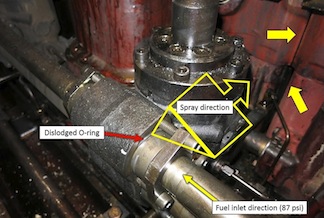The following is text from a marine accident brief issued by the National Transportation Safety Board (NTSB):
(WASHINGTON) — On Dec. 8, 2015, at 0509 local time, a fire broke out in auxiliary engine room No. 1 on board the containership Gunde Maersk shortly after the vessel departed Terminal 46 in Seattle, Wash. The fire was quickly extinguished by the vessel’s high pressure water mist system. As a result of the fire damage, the vessel lost propulsion and required tugboats to return to its berth. There was no environmental damage and none of the 23 crewmembers were injured. Damage was estimated at $380,000.
Investigators determined that the fire was caused by fuel leaking from a dislodged 1.5-inch-diameter O-ring in the fuel supply line to the No. 3 cylinder fuel injection pump, located near the top of auxiliary engine No. 1. Fuel in the supply line, pressurized to 87 pounds per square inch (psi), sprayed out around the O-ring. Some of the spray struck shields designed to prevent atomized fuel from spraying the engine room, while the remainder of the spray entered the exhaust side of the engine through the space between the cylinder heads. The fuel that struck the spray shields dripped into a fuel drain channel that ran the length of the engine under the fuel supply pipe. The fuel then drained into the 5-liter-capacity overflow tank until the tank was filled, sounding the tank overflow alarm.
The source of ignition was most likely fuel spraying and flowing onto the exhaust side of the engine between the cylinder covers. The exact time the leak began could not be determined, but it continued for a long-enough period to fill the overflow tank before the fire started. The fuel overflow tank alarm activated 13 seconds before the fire alarm sounded.
Probable cause
The National Transportation Safety Board determines that the probable cause of the fire aboard the containership Gunde Maersk was an improperly installed fitting on a fuel line supplying a fuel injector pump for auxiliary engine No. 1.
Click here to read the complete report.

